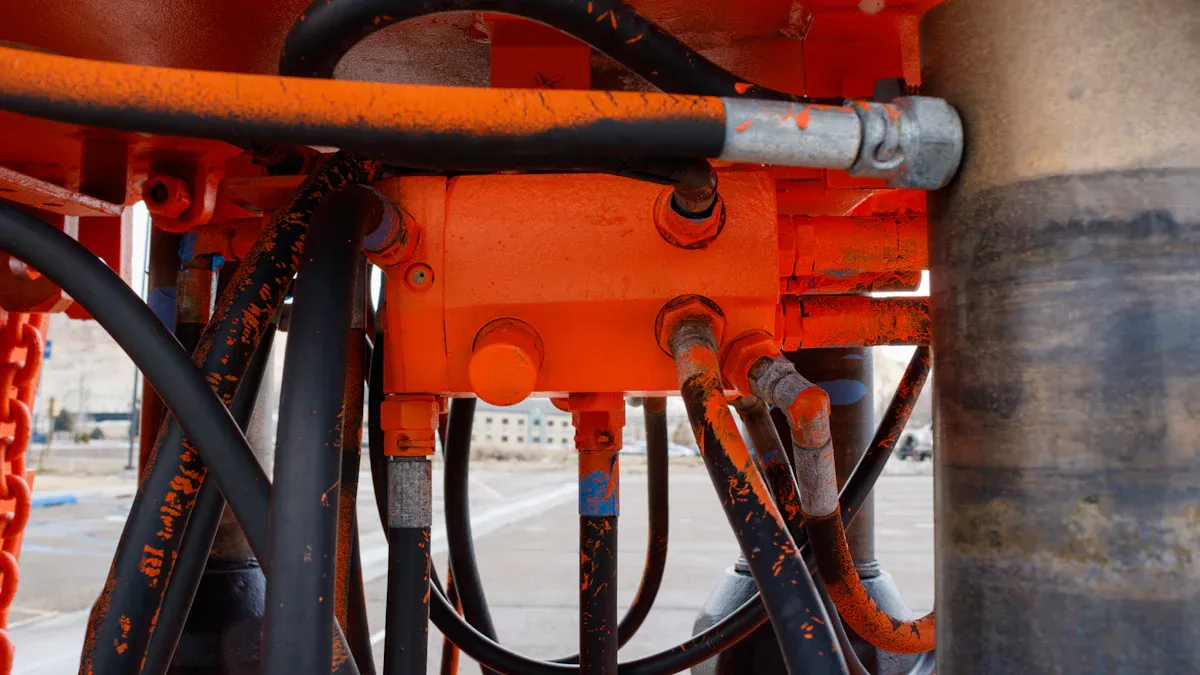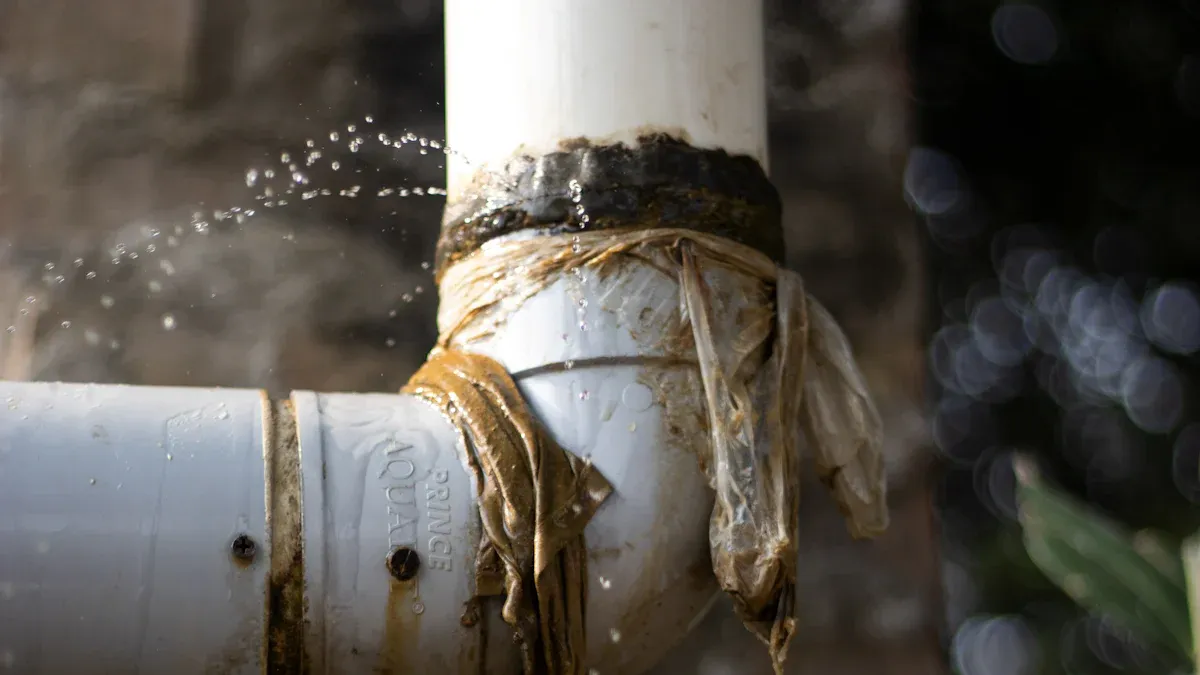
Construction machines depend on hydraulic fittings to keep pressure steady and systems safe. When workers install the wrong joint seal, oil can leak out—even a small drip adds up to 16 liters lost each year. This fluid loss increases costs, promotes corrosion, and weakens pipe fittings. Operators might face safety hazards like slippery spills or even hose whipping from faulty hydraulic hose fittings. Stainless steel fittings and rubber hose connections also suffer, as corrosion can cut burst resistance by 40%. These problems lead to more breakdowns and expensive repairs.
Key Takeaways
- Using the wrong joint seal causes oil leaks that waste fluid, increase costs, and damage machine parts.
- Proper seals keep hydraulic systems safe by preventing leaks, protecting parts, and reducing repairs.
- Regular checks and correct installation of seals help avoid safety hazards, costly downtime, and environmental harm.
The Importance of Joint Seals in Hydraulic Fittings

What Is a Joint Seal and Its Function
A joint seal acts like a gatekeeper in hydraulic fittings. It sits between two connecting parts and blocks fluid from escaping. In construction machines, these seals come in many forms, such as O-rings or face seals. O-Ring Face Seal (ORFS) fittings use an O-ring that presses tightly against the fitting face. This design creates a leak-free seal, even when the system faces high pressure or strong vibrations. Joint seals do more than just stop leaks. They help keep the hydraulic system clean by blocking dirt and other contaminants. This keeps machines like excavators and loaders running safely and smoothly.
Tip: Choosing the right seal material matters. For example, rubber seals like Nitrile work well for lower pressures, while elastomeric seals such as Viton handle higher temperatures and chemicals. Metal seals, like stainless steel, stand up to extreme pressure and heat.
| Material Type | Key Properties | Best Use Case |
|---|---|---|
| Rubber (Nitrile) | Flexible, cost-effective | Low to medium pressure, oil resistance |
| Elastomeric (Viton) | High temp, chemical resistance | High temp, aggressive fluids, long seal life |
| Metal (Steel) | Extreme pressure, wear resistant | High-pressure, high-temperature environments |
How Joint Seals Maintain Hydraulic System Integrity
Joint seals play a big role in keeping hydraulic systems strong and reliable. They stop fluid leaks by holding tight between parts, even when the system faces high pressure or heat. Seals also help keep the right amount of pressure inside the system, which makes machines work better and saves energy. When seals use tough materials and smart designs, they last longer and need fewer repairs.
- Joint seals prevent leaks and keep pressure steady, even in tough conditions.
- They block dirt and water, which protects the inside of the system.
- Good seals cut down on maintenance and help machines run longer without stopping.
- Special designs, like backup rings and anti-extrusion devices, help seals survive high pressure and temperature.
If someone picks the wrong seal or installs it the wrong way, the system can lose pressure, leak fluid, or even break down. That’s why it’s important to match the seal to the fluid, temperature, and pressure in the hydraulic fittings. Regular checks and the right installation keep everything working safely.
Risks of Using the Wrong Joint Seal in Hydraulic Fittings

Oil Leakage and Fluid Loss
When construction crews use the wrong joint seal, leaks often show up fast. Oil can drip from spots where the seal does not fit right. These leaks waste hydraulic fluid and lower system pressure. Some of the most common leaks happen with all-metal fittings, like JIC 37-degree flare joints. These need perfect metal-to-metal contact. If someone damages the flare or does not tighten it enough, oil escapes. O-ring fittings do better, but missing or worn O-rings still cause leaks. Problems also pop up when threads get damaged or seals get squeezed out during assembly.
- Damaged or missing O-rings let oil leak out.
- Scratched or bent threads stop the seal from working.
- Not tightening the fitting enough leaves gaps for oil to escape.
- Over-tightening can crush seals, making them fail.
Replacing O-rings and using the right torque helps prevent these leaks. Workers should always check seals before putting hydraulic fittings together.
Equipment Damage and Component Failure
Oil leaks do more than make a mess. They can damage important machine parts. When seals fail, hydraulic cylinders lose fluid. This causes the cylinder to drift or move when it should stay still. Cylinder rods can get scratched or bent if debris gets inside through a bad seal. Misaligned parts wear out faster and break down sooner. Corrosion also becomes a problem when water or dirt sneaks in through a faulty seal.
- Hydraulic cylinders lose power and drift.
- Cylinder rods bend or scratch from debris.
- Internal leaks cause parts to wear out.
- Corrosion weakens metal parts and seals.
Regular checks and using the right seal keep machines running longer. Clean parts and careful installation help avoid these problems.
Safety Hazards for Operators and Worksites
Leaking hydraulic fluid creates real dangers for workers. Slippery oil on the ground can cause slips and falls. High-pressure leaks might spray fluid, which can burn skin or hurt eyes. If oil lands on hot engine parts, it can even start a fire. Sometimes, a sudden loss of pressure makes equipment move in ways no one expects. This can lead to accidents or injuries.
- Slippery surfaces increase the risk of falls.
- High-pressure bursts can cause burns or eye injuries.
- Oil on hot parts can catch fire.
- Sudden equipment movement puts workers at risk.
Operators need to spot leaks early and fix them fast. Safety checks and good seals protect everyone on the job site.
Environmental Impact from Hydraulic Fluid Spills
Hydraulic fluid spills harm the environment. Oil can soak into soil or wash into rivers and lakes. This pollution hurts plants, animals, and even people. In one case, a construction project near Lake Washington had nine spills in just over a year. These spills ranged from a cup of oil to thousands of gallons of slurry. The leaks came from joint seal failures and cracks in hoses. The company got fined $22,000 for not protecting water quality.
| Aspect | Details |
|---|---|
| Regulatory Body | Washington State Department of Ecology |
| Violations | Nine spills, including hydraulic oil and slurry |
| Spill Volumes | From one cup to 8,000 gallons |
| Cause | Joint seal leaks and hose cracks |
| Fine | $22,000 |
Laws like the Clean Water Act and Oil Pollution Act require companies to prevent spills. Breaking these rules can lead to big fines and legal trouble. Spills also damage a company’s reputation and can cause long-term harm to the environment.
- Oil spills pollute soil and water.
- Wildlife and plants suffer from contamination.
- Companies face fines and cleanup costs.
- Repeated spills can lead to stricter rules and lost business.
Increased Maintenance Costs and Repairs
Using the wrong joint seal means more repairs and higher costs. Leaks let in dirt, water, and chemicals. These speed up wear and tear on machine parts. Workers have to patch the same spots over and over. Cleaning up oil and debris takes more time and money. Machines break down more often, and parts need replacing sooner.
| Operational Issue | How Incorrect Joint Seals Affect It | Consequences on Repair Frequency and Costs |
|---|---|---|
| Frequent Repairs | Leaks let in dirt and water | More repairs, higher costs |
| Equipment Wear and Tear | Rough joints cause jolts and vibrations | Shorter equipment life, more replacements |
| Cleaning Inefficiency | Oil and debris build up | More cleaning, higher labor costs |
| Structural Damage | Water and chemicals weaken parts | Expensive repairs over time |
| Workflow Disruption | Uneven surfaces slow machines | Lost productivity, higher costs |
Choosing the right seal and checking it often saves money. It also keeps machines working longer and better.
Operational Downtime and Project Delays
When hydraulic fittings leak or fail, machines stop working. Crews have to wait while repairs happen. This downtime wastes labor hours and slows down the whole project. Delays can lead to missed deadlines and even fines. Costs go up as companies pay for repairs, overtime, and sometimes rental equipment. Each day lost adds to the project’s total cost.
- Hydraulic failures stop machines and workers.
- Lost time means higher labor and repair bills.
- Delays can lead to penalties and hurt a company’s reputation.
- Quick repairs and good maintenance help keep projects on track.
Regular checks and using the right joint seal prevent these costly delays. Investing in good seals and maintenance pays off by keeping projects moving and budgets under control.
Selecting the right joint seal for hydraulic fittings keeps machines safe and projects on track.
- Regular checks, careful installation, and cleaning help spot problems early.
- Good maintenance saves money and prevents breakdowns.
Choosing the right seal protects equipment, workers, and your budget.
FAQ
What happens if someone uses the wrong joint seal in a hydraulic fitting?
Oil leaks out. Machines lose power. Workers face safety risks. Repairs cost more. Projects slow down. Everyone wants to avoid these problems.
Tip: Always check the seal type before installing a fitting.
How can a crew spot a failing hydraulic joint seal?
They see oil drips, hear hissing sounds, or notice weak machine movement. Sometimes, dirt collects around the fitting. Quick checks help catch problems early.
Which seal material works best for high-pressure construction machines?
Metal seals, like stainless steel, handle high pressure and heat. They last longer in tough jobs. Crews choose them for heavy-duty equipment.
Post time: Aug-11-2025
